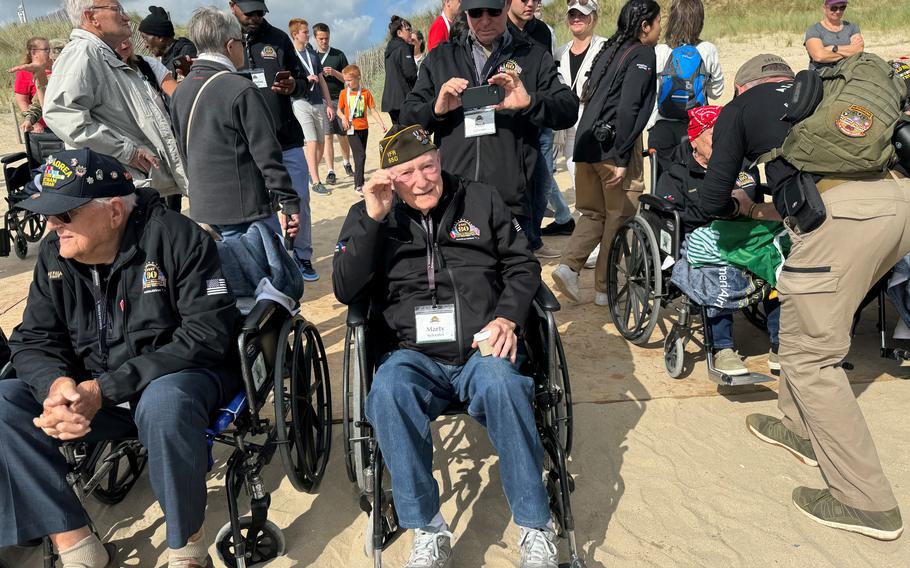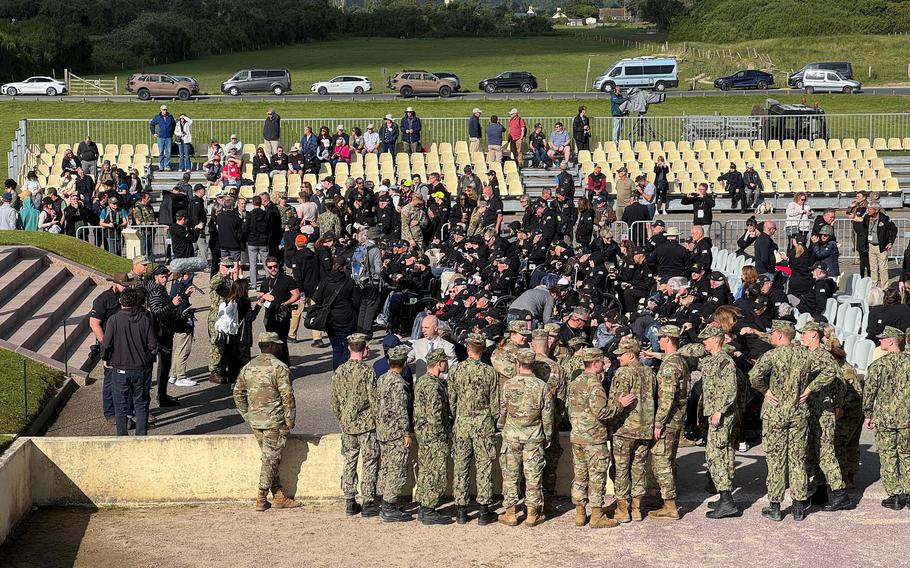
Martin “Marty” Sylvester, center, and his son, Paul, visit Utah Beach with a group of veterans on Wednesday, June 5, 2024. Sylvester landed at Utah Beach on June 7, 1944, the day after D-Day. (Robert H. Reid/Stars and Stripes)
UTAH BEACH, France — Martin “Marty” Sylvester didn’t find things so bad at Utah Beach when he landed on June 7, 1944, the day after D-Day. His life would get a lot worse.
By the time Germany surrendered in May 1945, the young rifleman with the 12th Regiment, 4th Infantry Division had been wounded, escaped German captivity three times, nearly been killed by friendly fire, lost a brother in combat, witnessed the start of the Battle of the Bulge and saw his weight drop to 80 pounds.
He turned 98 last April and has traveled to Normandy with his son, Paul, on a tour organized by American Airlines to attend the 80th anniversary commemoration of the D-Day landings.
His military story began soon after his 18th birthday when a draft notice interrupted his freshman year at Brooklyn College.
He was sent to basic training in Alabama — a different world for a Jewish kid from Brooklyn — and then on to England as a replacement in the 4th Infantry Division.

World War II veterans assembled Wednesday, June 5, 2024, for a ceremony at Utah Beach, a day before the 80th anniversary of the D-Day landings in Normandy, France. (Robert H. Reid/Stars and Stripes)
On June 7, 1944, his company was rousted before dawn, driven to the harbor and loaded onto a ship headed for Normandy.
“We never knew where we were going,” he told Stars and Stripes this week. “One day they woke us up and said ‘move out with full field pack,’ so we figured we weren’t coming back.”
His division had seized Utah Beach the day before with fewer than 200 combat deaths, compared with an estimated 777 Americans killed at the nearby Omaha Beach.
“When we arrived at Utah there was no fighting, although we could hear the fighting in the distance,” he said. “There were a few dead Germans around but the American dead had been taken away.”
As the Normandy campaign unfolded, his division captured Sainte-Mere-Eglise and pushed the Germans across France.
However, his clearest and most painful memories are from the Battle of the Huertgen Forest, where the U.S. suffered at least 33,000 deaths in months of fierce fighting.
“The Huertgen Forest was bad,” he told the New York State Military Museum in a 2001 interview. “I’d only been in the company a few months but I think I was the seventh-most senior guy. The others were all dead.”
He remembers one mortar attack in which the Germans used shells that exploded in the air, shearing off tops of trees and showering the Americans with hot metal shrapnel and pieces of wood as they desperately tried to burrow into the ground.
Sylvester said his favorite weapon was the M1 rifle but when the soldier carting the Browning Automatic Rifle, or BAR, was wounded, he volunteered to carry the weapon.
“The BAR plus the ammunition weighed almost as much as I did,” he recalled.
After months of intense combat and heavy losses, Sylvester’s unit was pulled off the line and sent for rest to Echternach, a resort town on the border between Luxembourg and Germany.
“They took our weapons to be cleaned,” he said. “We were sleeping in abandoned houses and eating hot food.”
His regiment maintained an observation post on a hill overlooking the border with Germany along the Sauer River, a tributary of the Moselle River.
Sylvester drew duty at the outpost. On the morning of Dec. 16, 1944, he was awakened by the soldier he was supposed to relieve.
“He said, ‘Red, you have to see this’ and handed me the binoculars,” he told the New York State Museum.
“There were thousands of Germans crossing the river on floating bridges they had put up overnight,” he said.
It was the beginning of the Battle of the Bulge, Nazi dictator Adolf Hitler’s go-for-broke plan to turn back the Western Allies.
“We called our company headquarters and they told us something like ‘we’re up to our asses in Krauts.’ Get the hell out of there but don’t come back here. The company is surrounded.”
For weeks, Sylvester and another soldier eluded the Germans, moving at night until they reached American lines, he said.
Weeks later, he wasn’t so lucky. After clearing a German village, during which a bullet passed through his ankle, he and others ended up in a basement where his lieutenant suggested they start a fire and eat.
He asked the lieutenant about the possibility of a German counterattack but was told not to worry because the company’s heavy weapons platoon was setting up a perimeter around the village.
Moments later, they heard German soldiers shouting, “Come out!”
A German armed with two grenades stood at the top of the basement stairs.
“The lieutenant said one grenade could take out all of us,” he said. “We heard later they were part of a patrol sent to take prisoners. Otherwise they would have killed us.”
The prisoners were marched to a barn where a German officer interrogated each of them separately in a makeshift office in the lift.
“He spoke perfect English and told me ‘your war is over,’” he said.
The officer asked where he was from and when he said New York, the German told him he’d lived in New York for 10 years on Manhattan’s West Side in an apartment overlooking the George Washington Bridge.
Then things turned bad. Sylvester said he was asked the names of his commanders, and he replied he didn’t know.
“He picked up a Luger (pistol) from his desk and screamed ‘you’re just a dirty Jew.’ I thought he was going to shoot me. Instead, he shoved me down the stairs. I was relieved.”
That was the only time his religion was ever mentioned in captivity, he said.
With the Americans advancing, the Germans marched their captives north away from U.S. lines, he said.
Security on the march was lax, Sylvester said, and he slipped away, only to be recaptured later.
He got away again on a subsequent march but was recaptured and this time sent by rail to a camp where prisoners made wood chips that the Germans used for fuel.
On the way to that camp, prisoners were loaded into rail cars, which were strafed by American fighter planes.
“Bullets were coming into the cars and some guys were hit,” he said in the New York interview.
The prisoners convinced the Germans to stop the train and allow the prisoners to exit the cars. They went into a field and lined up forming the letters POW, he said.
“The pilot dipped his wings and flew off,” he said.
Another forced march from the prison camp afforded an opportunity for escape No. 3, he said.
Traveling at night, Sylvester said he reached the edge of a village. Two uniformed men spotted him and pointed in his direction. But instead of trying to catch him, they left.
He slipped into the village and took refuge in a cellar. A woman there offered him food, shelter and a bath instead of turning him in.
“I learned the two men who spotted me were SS but they were evacuating the town,” he said. “The SS didn’t mess around. If they’d caught me, they’d have killed me.”
Days later, the woman banged on the door of the room where he was sheltering. He looked out the window and saw an American tank.
He went out and reported to an officer, who provided a vehicle to take him to an aid station.
From there he was flown to a U.S. hospital in Paris, where he heard of the death of President Franklin D. Roosevelt and the German surrender.
Doctors told him he had developed gangrene from the ankle wound and in another week he would have lost his leg. One more week after that and he would have lost his life.
He weighed 80 pounds and suffered from typhus.
Only then did he learn that his brother Ernie had been killed in the Huertgen Forest.
“I didn’t even know he was in the Huertgen Forest,” Sylvester said. “My parents got two telegrams in one week. One said my brother was dead. The other said I was missing in action.”
After the war, Sylvester resumed his university studies and became a psychological therapist.
He said he returned to Normandy for the 50th anniversary in 1994 but hadn’t been back since. He decided to return mostly because of his son.
He also wanted to pay homage to the estimated 4,414 Allied soldiers killed on June 6, 1944. About 2,500 of them were Americans, most killed on “Bloody Omaha.”
“I’m not going back to a place where I was having a good time,” he joked. “People were trying to kill me.”